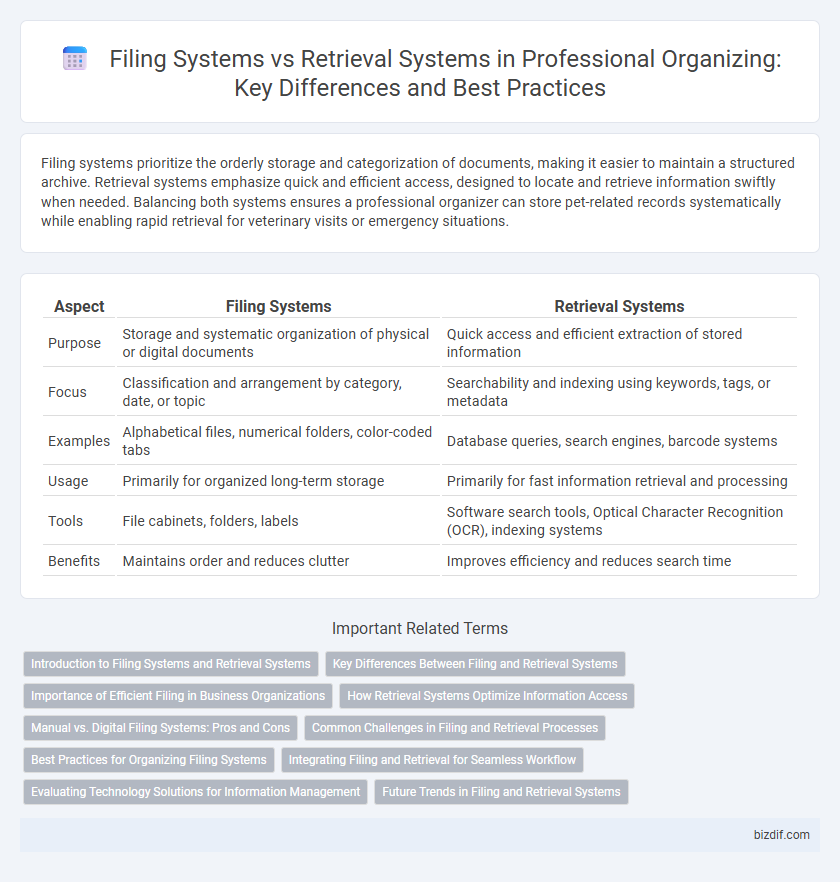Filing systems prioritize the orderly storage and categorization of documents, making it easier to maintain a structured archive. Retrieval systems emphasize quick and efficient access, designed to locate and retrieve information swiftly when needed. Balancing both systems ensures a professional organizer can store pet-related records systematically while enabling rapid retrieval for veterinary visits or emergency situations.
Table of Comparison
| Aspect | Filing Systems | Retrieval Systems |
|---|---|---|
| Purpose | Storage and systematic organization of physical or digital documents | Quick access and efficient extraction of stored information |
| Focus | Classification and arrangement by category, date, or topic | Searchability and indexing using keywords, tags, or metadata |
| Examples | Alphabetical files, numerical folders, color-coded tabs | Database queries, search engines, barcode systems |
| Usage | Primarily for organized long-term storage | Primarily for fast information retrieval and processing |
| Tools | File cabinets, folders, labels | Software search tools, Optical Character Recognition (OCR), indexing systems |
| Benefits | Maintains order and reduces clutter | Improves efficiency and reduces search time |
Introduction to Filing Systems and Retrieval Systems
Filing systems organize documents by categorizing and storing them for easy management and long-term preservation, utilizing methods such as alphabetical, numerical, or chronological order. Retrieval systems focus on the efficient access and extraction of stored information, employing tools like indexing, metadata tagging, and digital search functionalities for quick document location. Integrating effective filing systems with retrieval strategies enhances productivity by minimizing time spent on document handling and improving workflow efficiency.
Key Differences Between Filing and Retrieval Systems
Filing systems focus on the systematic categorization and storage of documents to ensure order and prevent loss, using methods such as alphabetical, numerical, or subject-based classification. Retrieval systems prioritize quick and efficient access to stored information through indexing, tagging, or digital search capabilities, enabling faster location of specific documents. Key differences lie in filing's emphasis on long-term organization and retrieval's focus on speed and ease of access.
Importance of Efficient Filing in Business Organizations
Efficient filing systems in business organizations streamline document storage and improve information retrieval, reducing time spent searching for important files by up to 50%. Well-organized filing enhances workflow productivity, supports compliance with regulatory requirements, and safeguards sensitive data. Implementing customized retrieval systems tailored to business needs ensures quick access to critical documents, driving operational efficiency and informed decision-making.
How Retrieval Systems Optimize Information Access
Retrieval systems optimize information access by categorizing and indexing documents based on user behavior and search patterns, which significantly reduces the time spent locating files. Unlike traditional filing systems that organize papers by static labels or alphabetical order, retrieval systems employ digital tags, metadata, and full-text search capabilities for dynamic and precise information retrieval. This method enhances efficiency in professional organizing, ensuring critical documents are accessible instantly when needed.
Manual vs. Digital Filing Systems: Pros and Cons
Manual filing systems offer tactile organization and easy access without the need for technology, ideal for small volumes and low-tech environments but prone to physical damage and slower search times. Digital filing systems enhance retrieval speed with keyword searches and remote access while supporting backup and space-saving storage but depend on reliable hardware and cybersecurity measures. Balancing manual and digital filing systems requires assessing factors like document volume, security needs, and user proficiency to optimize organizational efficiency.
Common Challenges in Filing and Retrieval Processes
Inefficient filing systems often lead to misfiled documents, causing delays and increased stress during retrieval. Common challenges include inconsistent labeling, lack of standardized categorization, and inadequate indexing methods that hinder quick access to information. Implementing clear protocols and regularly updating filing systems can significantly improve retrieval accuracy and reduce time spent searching for documents.
Best Practices for Organizing Filing Systems
Effective filing systems prioritize clear categorization, consistent labeling, and logical hierarchy to streamline document storage and retrieval. Employing color-coding, standardized folders, and indexing methods enhances accessibility and reduces misplacement risks. Regular audits and updates of filing systems ensure longevity, accuracy, and alignment with evolving organizational needs.
Integrating Filing and Retrieval for Seamless Workflow
Integrating filing and retrieval systems enhances professional organizing by creating a seamless workflow that boosts efficiency and reduces time spent searching for documents. Combining structured file categorization with intuitive retrieval methods--such as keyword tagging and digital indexing--ensures rapid access while maintaining organization integrity. This holistic approach minimizes clutter and supports consistent information management across physical and digital environments.
Evaluating Technology Solutions for Information Management
Filing systems focus on systematically categorizing and storing documents for long-term preservation, while retrieval systems prioritize quick and efficient access to stored information through search functionalities. Evaluating technology solutions for information management requires assessing factors like user interface intuitiveness, integration capabilities with existing tools, and support for metadata tagging to enhance search accuracy. Emphasizing cloud-based retrieval systems with AI-powered search can significantly improve productivity in professional organizing by reducing time spent locating critical documents.
Future Trends in Filing and Retrieval Systems
Future trends in filing and retrieval systems emphasize integration of artificial intelligence and machine learning to enhance search accuracy and automate document categorization. Cloud-based platforms combined with advanced metadata tagging enable seamless access and collaboration across devices and locations. Innovations in voice recognition and natural language processing promise more intuitive, hands-free retrieval experiences, transforming traditional filing methods.
filing systems vs retrieval systems Infographic

 bizdif.com
bizdif.com